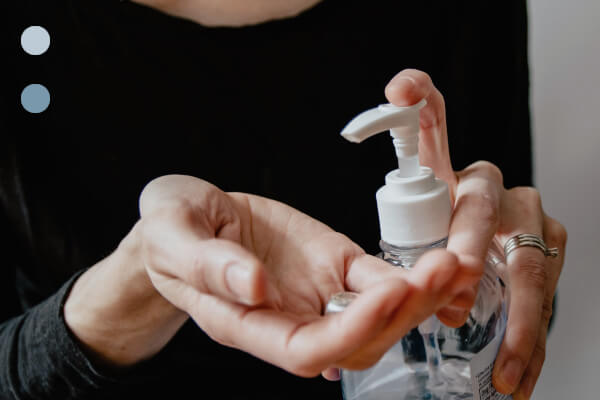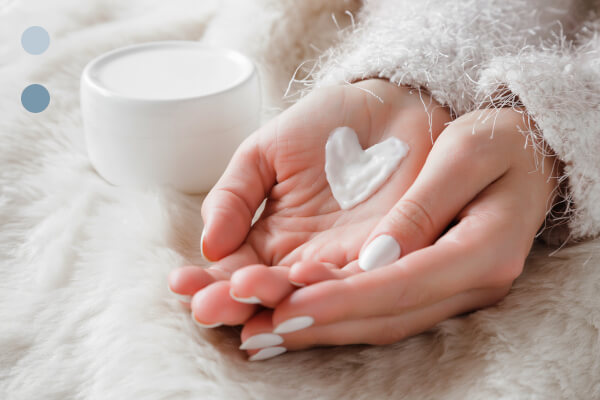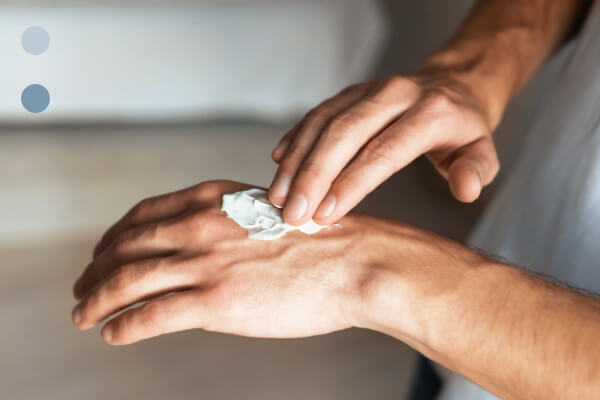
Good to know:
Hand hygiene at work
Good to know:
Hand hygiene
at work
Hand hygiene in everyday work

For people for whom thorough hand hygiene plays a particularly important role at work, frequent hand washing and disinfection have long been part of everyday life. This is especially true in healthcare and nursing, but also for kitchen and cleaning staff, in the laboratory, or in services with particularly close contact to other people, such as cosmetics or working with children.
Working in these industries often means you have to deal with dry and stressed hands. After all, regular hand washing not only removes germs, but also endangers the skin's natural protective layer.

Hand hygiene in everyday work

For people for whom thorough hand hygiene plays a particularly important role at work, frequent hand washing and disinfection have long been part of everyday life. This is especially true in healthcare and nursing, but also for kitchen and cleaning staff, in the laboratory, or in services with particularly close contact to other people, such as cosmetics or working with children.
Working in these industries often means you have to deal with dry and stressed hands. After all, regular hand washing not only removes germs, but also endangers the skin's natural protective layer.

Protection against germs, hazard for the skin
Especially if too hot or cold water is used or no milder soap is available at the workplace, fats can be rinsed out and the acid mantle of the top layer of skin can be attacked.
Often there are precise regulations on hand washing and disinfection. They are necessary to remove both dirt and invisible, more stubborn viruses, bacteria or fungi. But it is precisely this combination of cleaning agents and disinfectants, which is useful for work, that can additionally attack – and above all dry out – the skin.


Protection against germs,
hazard for the skin

Especially if too hot or cold water is used or no milder soap is available at the workplace, fats can be rinsed out and the acid mantle of the top layer of skin can be attacked.
Often there are precise regulations on hand washing and disinfection. They are necessary to remove both dirt and invisible, more stubborn viruses, bacteria or fungi. But it is precisely this combination of cleaning agents and disinfectants, which is useful for work, that can additionally attack – and above all dry out – the skin.

The proper cleansers for dry skin

Dry hands, reddening and cracks that quickly become inflamed are therefore not uncommon. In addition, eczema can form and in the worst case even become chronic if they are not treated appropriately in time.
And especially when regular hand hygiene is supposed to protect against pathogens, factors such as cracks and open areas become a problem several times over, because germs can then penetrate directly into the body through them. Therefore, the skin should be cared for and protected accordingly so that it does not get that far in the first place – for example by using pH-neutral washing preparations instead of aggressive soaps.

Wearing protective gloves also has its pitfalls. Although they are necessary in many areas to comply with hygiene regulations and to protect the hands, they can soak the skin there at the same time. This happens mainly with gloves that are liquid-tight for protection, for example against chemicals, so that sweat forms and remains in contact with the skin during prolonged wear.
In turn, pathogens and other harmful substances penetrate more easily into the sodden skin. To prevent this, it can be useful to wear additional cotton gloves under the necessary disposable gloves. This prevents fluid from accumulating and the skin barrier is less affected.
The proper cleansers for dry skin

Dry hands, reddening and cracks that quickly become inflamed are therefore not uncommon. In addition, eczema can form and in the worst case even become chronic if they are not treated appropriately in time.
And especially when regular hand hygiene is supposed to protect against pathogens, factors such as cracks and open areas become a problem several times over, because germs can then penetrate directly into the body through them. Therefore, the skin should be cared for and protected accordingly so that it does not get that far in the first place – for example by using pH-neutral washing preparations instead of aggressive soaps.

Wearing protective gloves also has its pitfalls. Although they are necessary in many areas to comply with hygiene regulations and to protect the hands, they can soak the skin there at the same time. This happens mainly with gloves that are liquid-tight for protection, for example against chemicals, so that sweat forms and remains in contact with the skin during prolonged wear.
In turn, pathogens and other harmful substances penetrate more easily into the sodden skin. To prevent this, it can be useful to wear additional cotton gloves under the necessary disposable gloves. This prevents fluid from accumulating and the skin barrier is less affected.

Hand creams as additional protection and care for strained hands
In addition, the sensitive skin on the hands can be protected from drying out by special creams. Protective creams are recommended before and during work, which can be supplemented by skin care creams after work and during leisure time. When using these products, it is important to ensure that they do not contain any ingredients that put additional stress on the skin, such as synthetic fragrances, mineral oils or chemical preservatives in the form of parabens.
For the regeneration of the skin and sustainable support from the inside, it is also necessary to use ingredients that do not only have a short-term, superficial effect and are thus quickly washed off again. Moisture that literally gets under the skin is provided by natural oils and fats, for example.
When protective gloves are worn, it is also important to ensure that the products are absorbed quickly and do not become greasy, as these gloves should only be worn on clean and dry skin.

Hand creams as additional protection and care for strained hands
In addition, the sensitive skin on the hands can be protected from drying out by special creams. Protective creams are recommended before and during work, which can be supplemented by skin care creams after work and during leisure time.
When using these products, it is important to ensure that they do not contain any ingredients that put additional stress on the skin, such as synthetic fragrances, mineral oils or chemical preservatives in the form of parabens.

For the regeneration of the skin and sustainable support from the inside, it is also necessary to use ingredients that do not only have a short-term, superficial effect and are thus quickly washed off again. Moisture that literally gets under the skin is provided by natural oils and fats, for example.
When protective gloves are worn, it is also important to ensure that the products are absorbed quickly and do not become greasy, as these gloves should only be worn on clean and dry skin.
